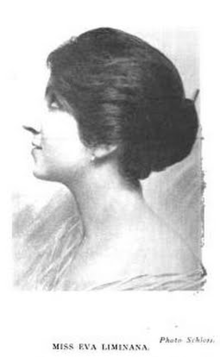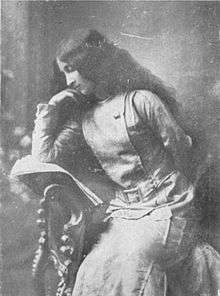Eva Limiñana
Eva Limiñana (December 22, 1895 – September 27, 1953), sometimes credited as La Duquesa Olga, was a pianist, screenwriter, and filmmaker born in Argentina and educated in Chile.


Early life
Eva Limiñana Salaverri was born in Gualeguaychú, Entre Ríos, Argentina, and raised in Chile. Her mother was Marie de Limiñana.[1] She studied piano at the Santiago Conservatory of Music, with further studies in Berlin with Martin Krause and (when World War I began)[2] in New York with Teresa Carreño.[3][4]
Career
Limiñana performed in New York as a pianist in 1917,[4][5] 1919,[6] and 1920.[3] Through the 1920s she played and recorded with Orquesta Criolla Argentina. In 1931 she made several musical recordings providing piano accompaniment for her husband, singer José Bohr.[7] She also wrote songs with Bohr.[8]
Limiñana wrote eight films: La sangre manda (1934), ¿Quién mató a Eva? (1934), Thy Son (1935), Luponini from Chicago (1935), Por mis pistolas (1938), Una luz en mi camino (1939), Herencia macabra (1940). She wrote and produced all of these films in Mexico with José Bohr, who also starred and directed. She was credited as "La Duquesa Olga".[9] She also produced Sueños de amor (1935), Marihuana (El monstruo verde) (1936), Such Is Woman (1936), and El látigo (1939) with him. Their films are described by a recent film historian as "disconcerting, horrifying, chaotic, extravagant, baroque, and confusing".[10]
In 1942, after the couple divorced, she wrote, directed, and produced her only film without Bohr, Mi lupe y mi caballo (1944).[11] After that, she retired from filmmaking.[12]
Personal life
Limiñana married German-born filmmaker and composer José Bohr (1901-1994) in 1925. She died in 1953, in Mexico City, aged 57 years.
References
- "Young Pianist Here from South America" San Francisco Chronicle (November 12, 1916): 23. via Newspapers.com

- "South Americans Study Here" Musical America (December 30, 1916): 35.
- "Eva Liminana to Give New York Recital" Musical Courier (September 2, 1920): 30.
- "Talented Young Pianist in New York" The South American (March 1917): 26.
- "Eva Liminana's Debut" Musical America (January 20, 1917): 40.
- "New Music from Spain" New York Times (December 15, 1919): 15.
- Discography of American Historical Recordings, s.v. "Eva Liminana (instrumentalist: piano)".
- Michael R. Pitts, Poverty Row Studios, 1929-1940: An Illustrated History of 55 Independent Film Companies, with a Filmography for Each (McFarland 2005): 342. ISBN 9780786423194
- Ana M. López, "Before Exploitation: Three Men of Cinema in Mexico" in Victoria Ruétalo, Dolores Tierney, eds., Latsploitation, Exploitation Cinemas, and Latin America (Routledge 2009): 21-24. ISBN 9781135848774
- Federico Dávalos Orozco, "The Birth of the Film Industry and the Emergence of Sound" in Joanne Hershfield, David R. Maciel, eds., Mexico's Cinema: A Century of Film and Filmmakers (Rowman & Littlefield 1999): 28. ISBN 9780585241104
- Annette Kuhn, Susannah Radstone, eds., The Women's Companion to International Film (University of California Press 1994): 263. ISBN 9780520088795
- Elissa J. Rashkin, Women Filmmakers in Mexico: The Country of Which We Dream (University of Texas Press 2000). ISBN 9780292774377
External links
Eva Limiñana on IMDb